An Accuracy Comparison of Micromechanics Models of Particulate Composites against Microstructure-Free Finite Element Modeling
Abstract
:1. Introduction
2. Materials and Methods
2.1. Microstructure-Free Finite Element Modeling (MF-FEM) of Composite Representative Volume Element (RVE)
2.2. The Selected Micromechanics Models of Particulate Composites
- The micromechanics model was explicitly developed for particulate or short-fiber reinforced composites, where the composites can be considered a homogeneous and isotropic material at the length scale of the RVE.
- The micromechanics model produces explicit analytical solutions for at least two of the four elastic properties.
- The analytical solutions do not require an empirical coefficient.
- (1)
- (2)
- The Hashin-Shtrikman (HS) bounds [23]
- (3)
- The Voigt–Reuss–Hill (VRH) average [24]
- (4)
- The Mori–Tanaka (MT) model [25]
- (5)
- The Generalized self-consistent (GSC) model [3]
- (6)
- The Isotropized Voigt-Reuss (Iso-VR) model [28]
- (7)
- The product of exponential functions (PEF) [29]
3. Results
- (1)
- The accuracy of the models is inhomogeneous over the range of volume fraction; see Figure A5, Figure A6, Figure A7 and Figure A8 in the Appendix A. For GSC and MT models, the maximum relative error usually occurs in the second half of the range. For VRH, Iso-VR, and PEF, the accuracy fluctuates over the range.
- (2)
- Only for Composite #1, which has small contrasts in both its phase Young’s moduli and phase Poisson’s ratios, all the models have reasonable accuracy in all four effective properties. The maximum relative error is below 1%; see Figure A5a, Figure A6a, Figure A7a and Figure A8a, in addition to Figure 2.
- (3)
- For Composite #2, which has a small contrast of phase Young’s moduli but a large contrast in phase Poisson’s ratios, the models have acceptable accuracy for effective Young’s modulus and effective shear modulus, with the maximum relative error below 6%. But the accuracy for effective bulk modulus and effective Poisson’s ratio is quite poor, with average error above 15%.
- (4)
- (5)
- Only if the contrasts of phase Young’s moduli and phase Poisson’s ratios are small, the VR and HS bounds are able to enclose the MF-FEM predictions.
- The gap between the upper and the lower bound of either HS or VR model is primarily dependent upon the contrast of phase Young’s moduli. If the contrast of phase Young’s moduli is small, the bounds are tight; otherwise, the bounds are loose. The contrast of phase Poisson’s ratios has a much lower significant effect on the gap.
- Contrary to the observations reported in some of the previous studies, the HS bounds may not be always enclosed by the VR bounds, e.g., the effective Young’s moduli in Figure 3b, the effective bulk moduli in Figure 5b, and the effective Poisson’s ratios in Figure 6b. This phenomenon is related to the large contrast of phase Poisson’s ratios.
4. Discussion
5. Conclusions
Funding
Institutional Review Board Statement
Informed Consent Statement
Data Availability Statement
Acknowledgments
Conflicts of Interest
Appendix A
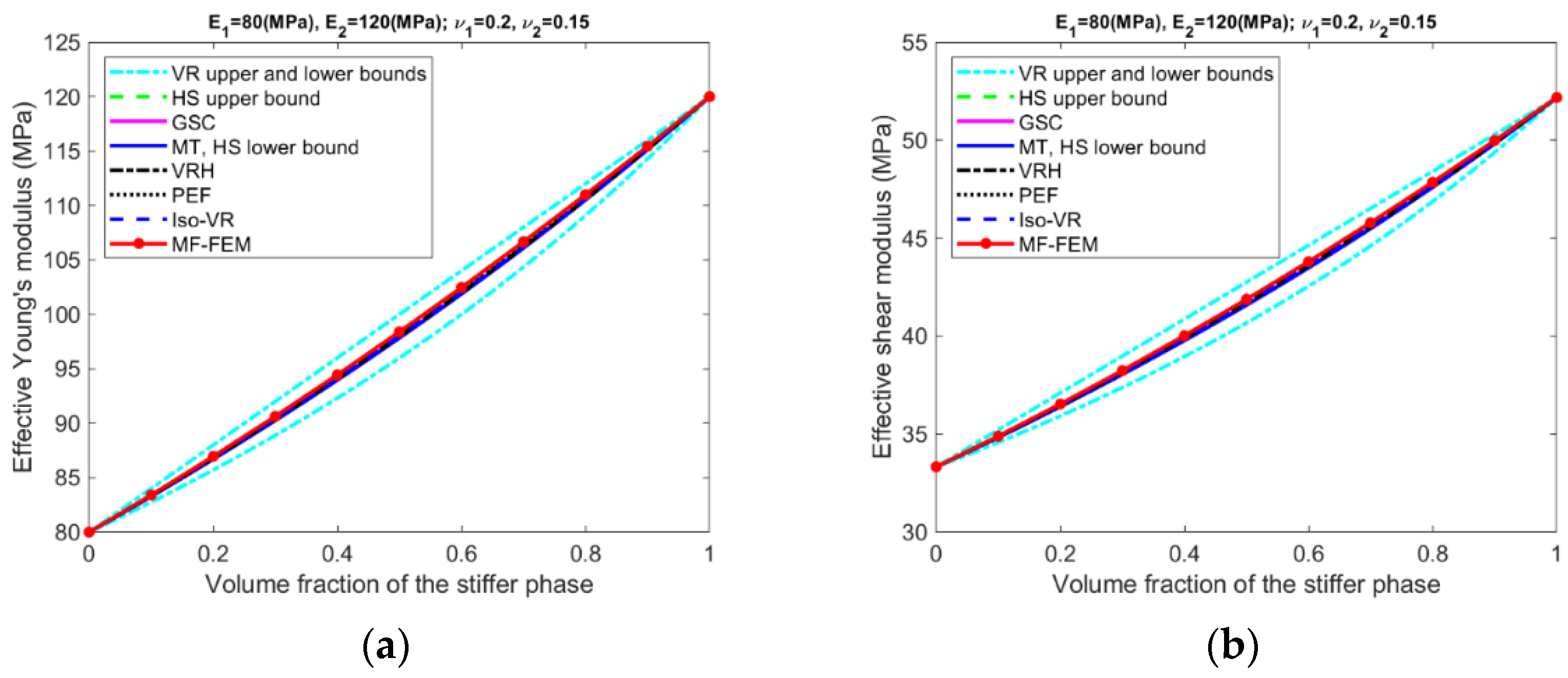
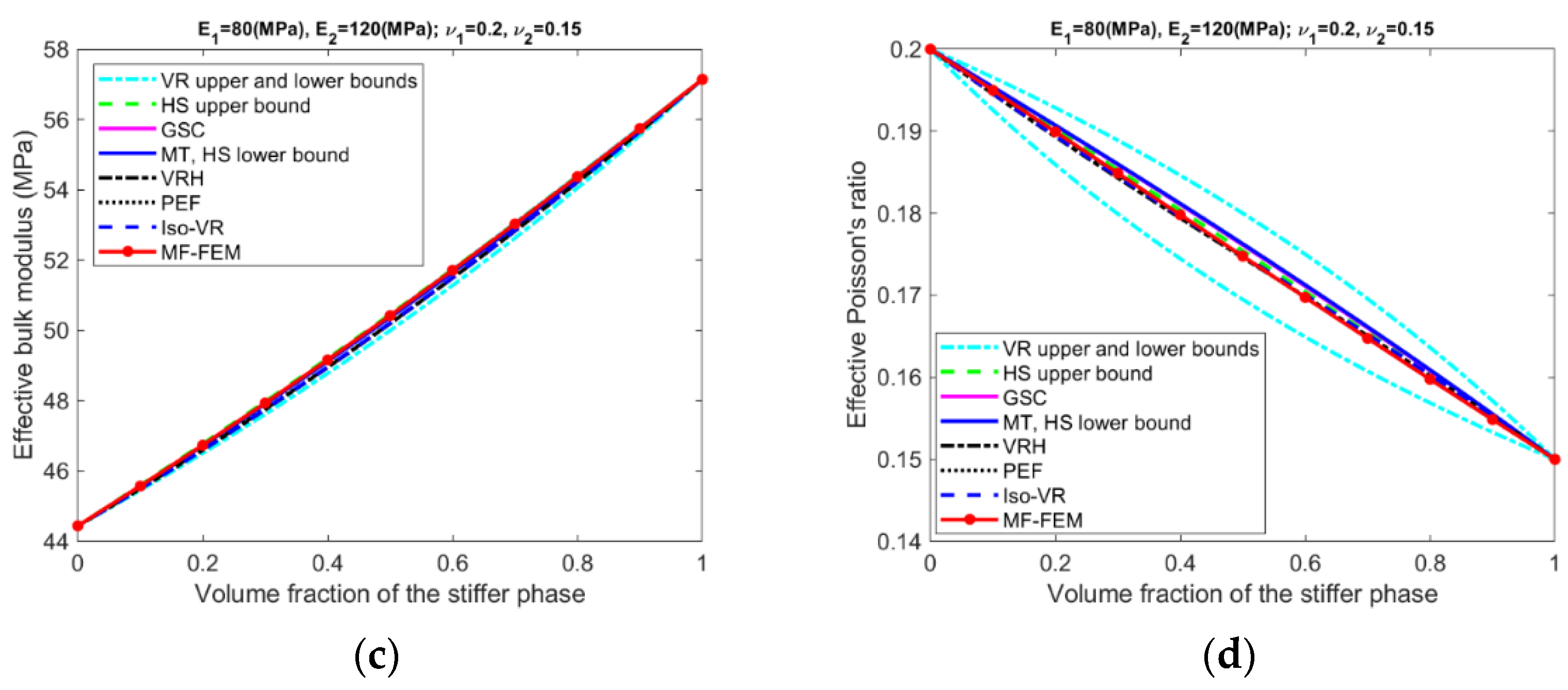
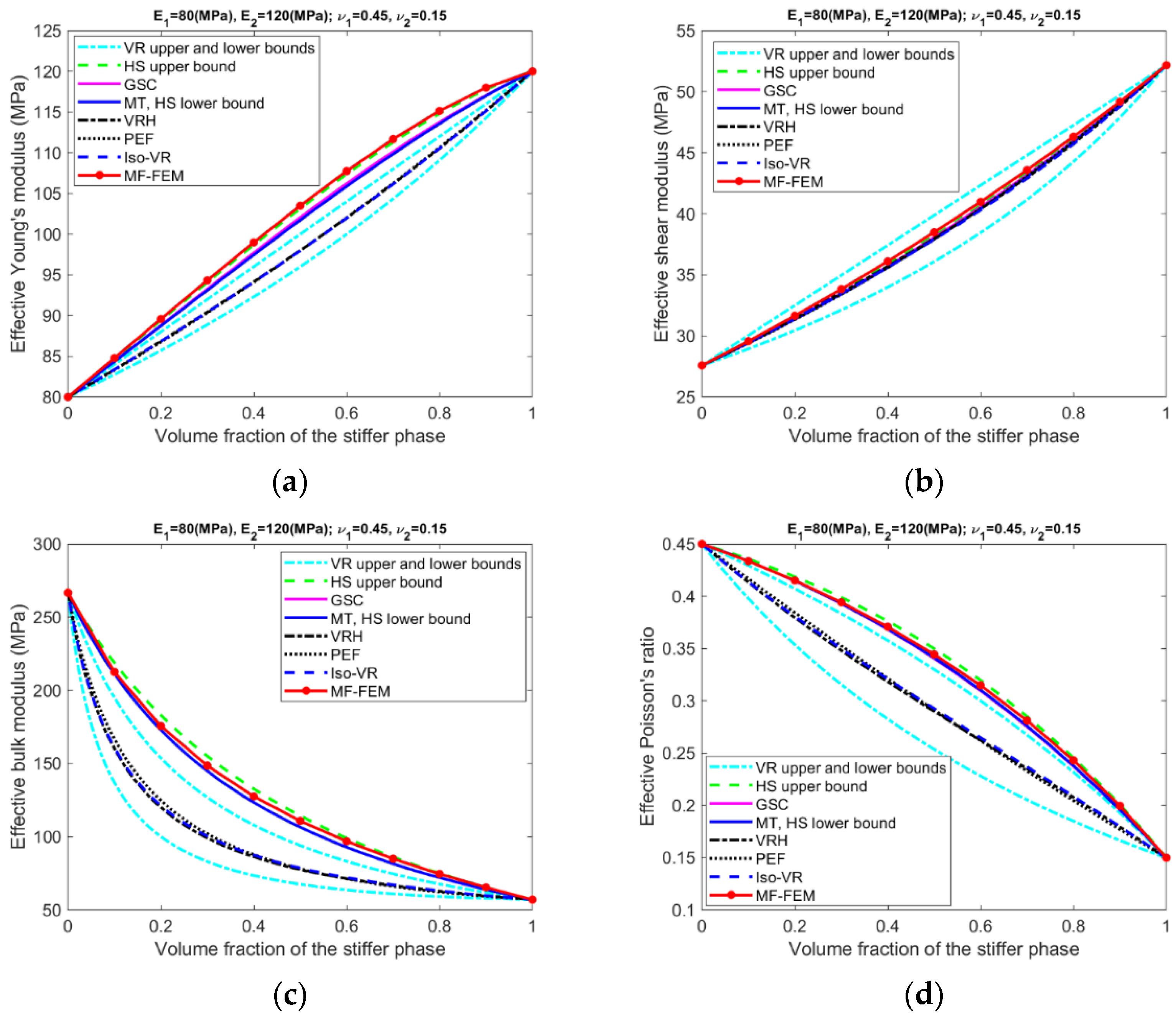
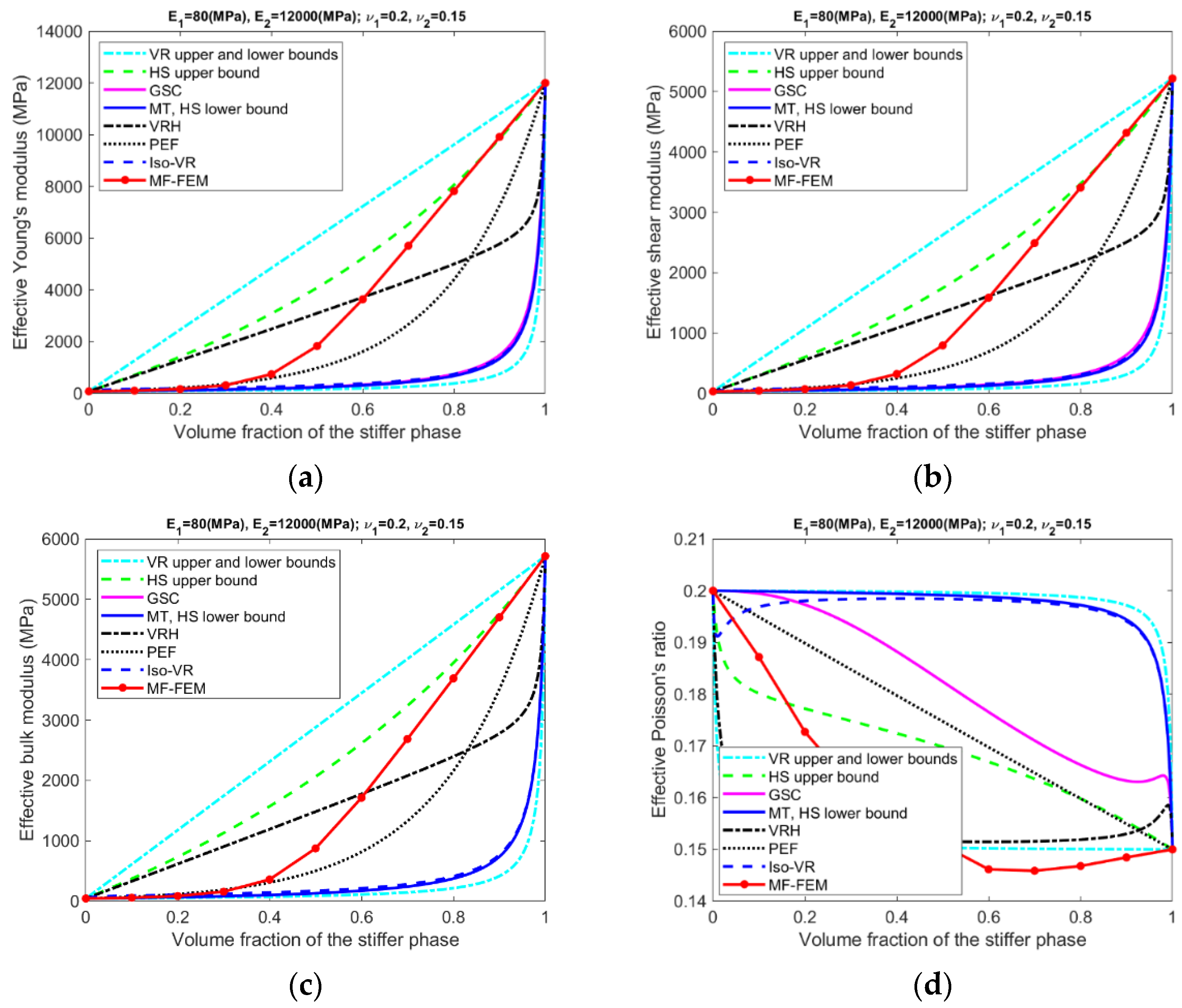

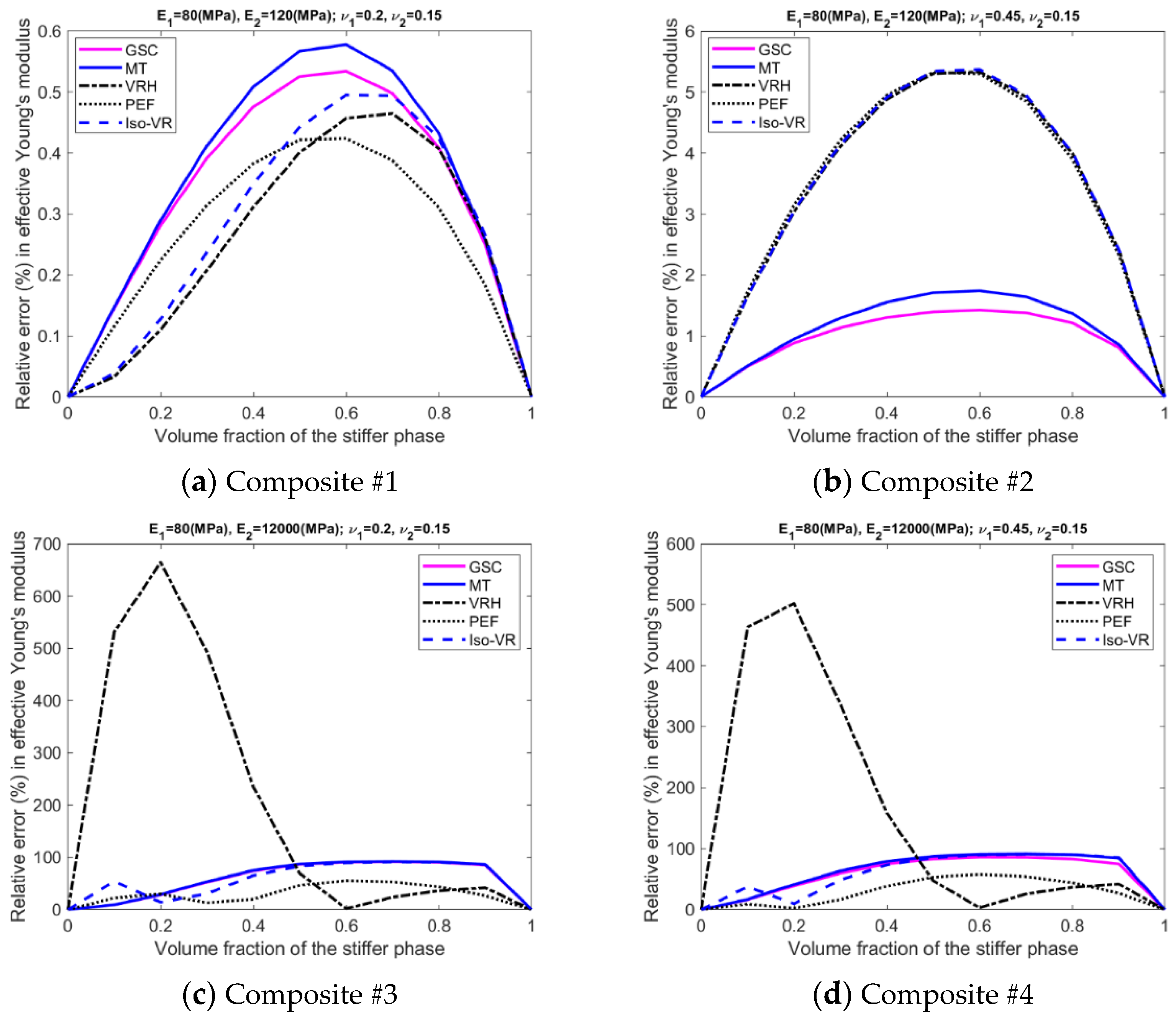
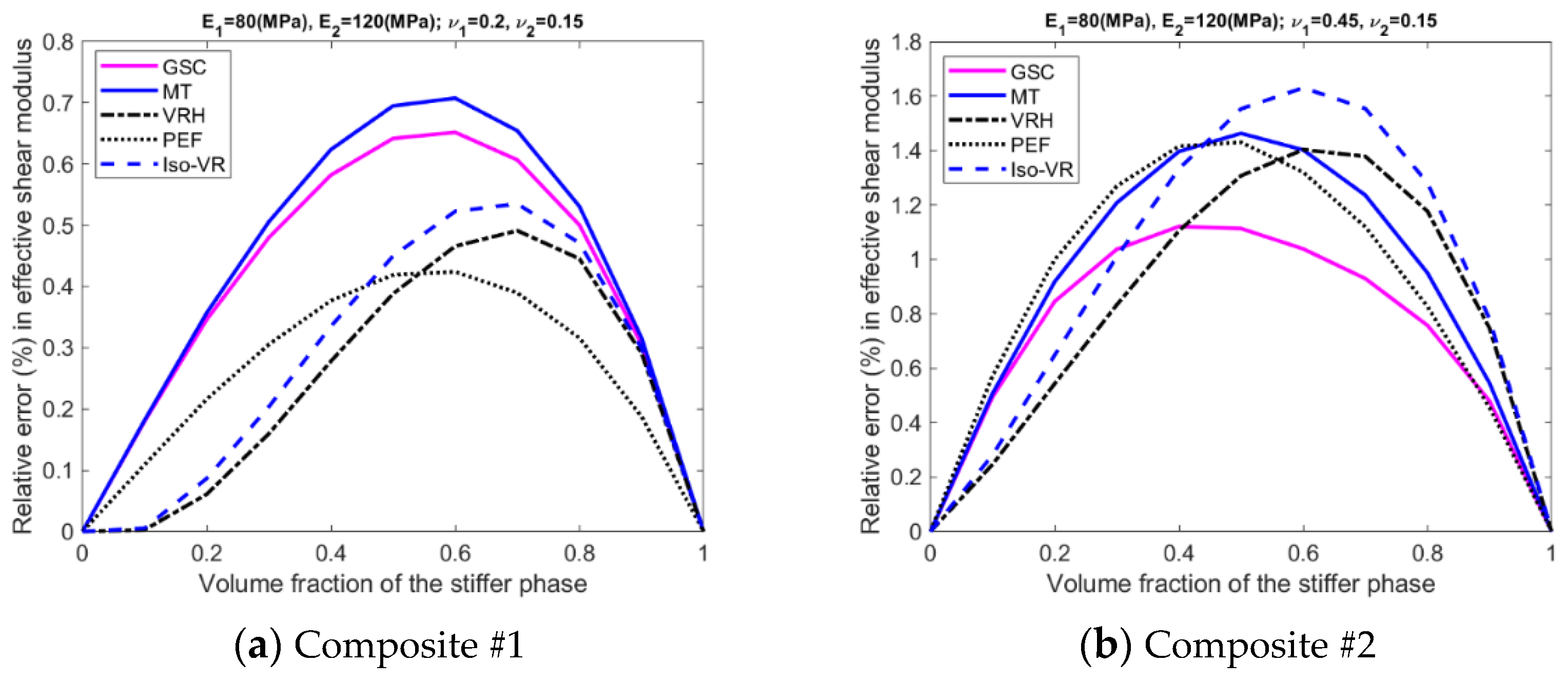
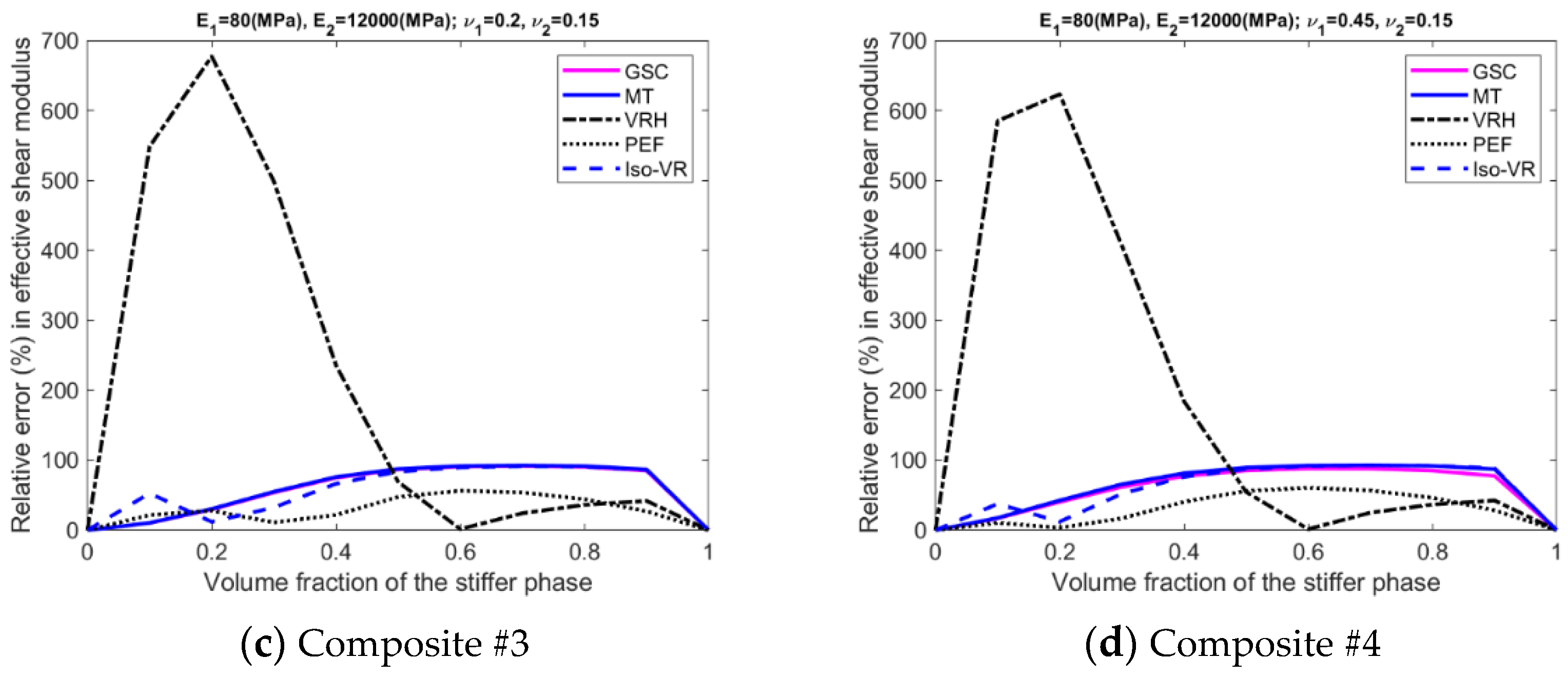

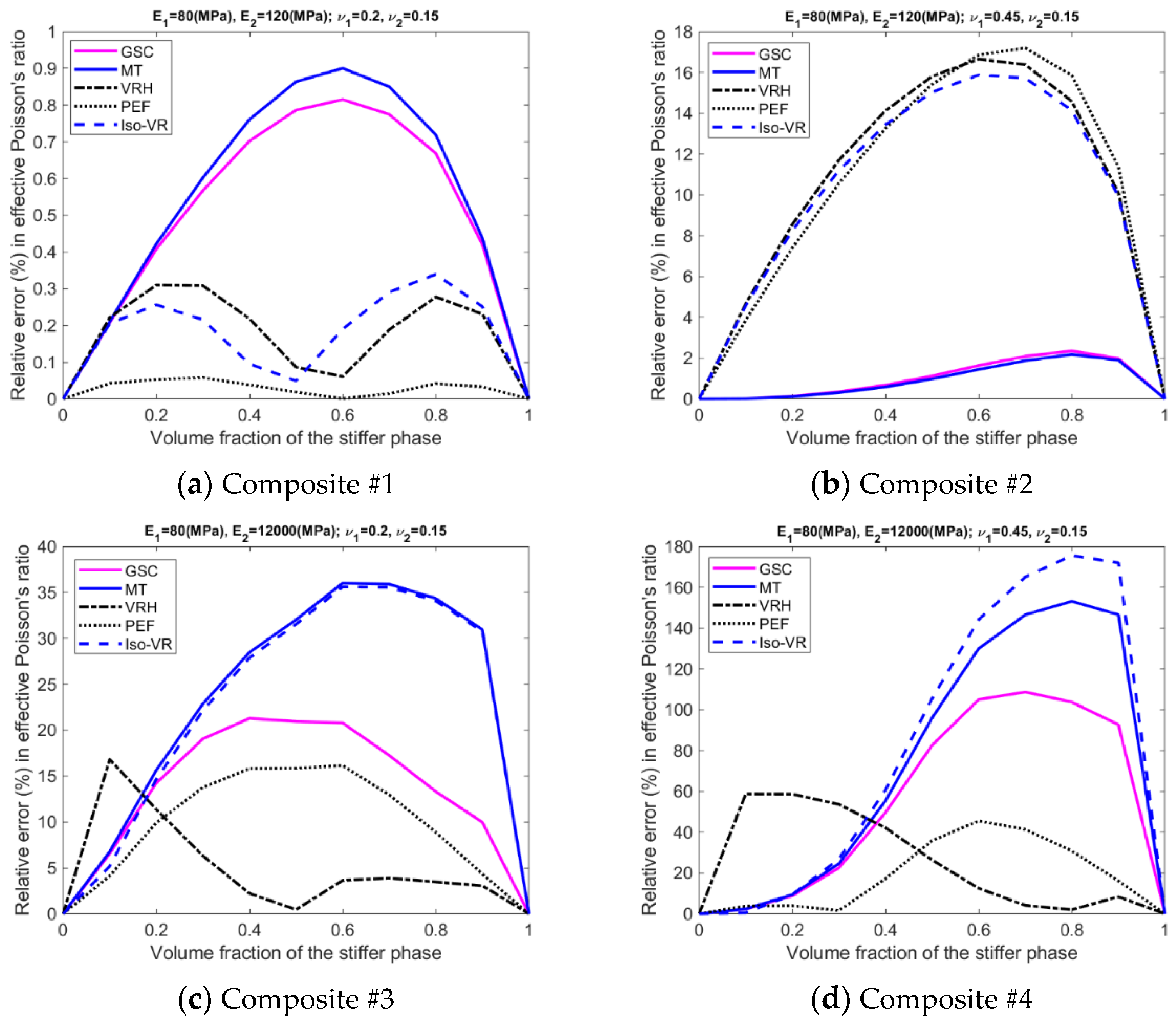
References
- Huang, H.-B.; Huang, Z.M. Micromechanical prediction of elastic-plastic behavior of a short fiber or particle reinforced composite. Compos. Part A Appl. Sci. Manuf. 2020, 134, 105889. [Google Scholar] [CrossRef]
- Jagadeesh, G.; Setti, S.G. A review on micromechanical methods for evaluation of mechanical behavior of particulate reinforced metal matrix composites. J. Mater. Sci. 2020, 55, 9848–9882. [Google Scholar] [CrossRef]
- Christensen, R.M. A critical evaluation for a class of micromechanics models. J. Mech. Phys. Solids 1990, 38, 379–404. [Google Scholar] [CrossRef]
- Kundalwal, S.I.; Ray, M.C. Effective properties of a novel composite reinforced with short carbon fibers and radially aligned carbon nanotubes. Mech. Mater. 2012, 53, 47–60. [Google Scholar] [CrossRef]
- Pindera, M.-J.; Khatam, H.; Drago, A.S.; Bansal, Y. Micromechanics of spatially uniform heterogeneous media: A critical review and emerging approaches. Compos. Part B 2009, 40, 349–378. [Google Scholar] [CrossRef]
- Raju, B.; Hiremath, S.R.; Roy Mahapatra, D. A review of micromechanics based models for effective elastic properties of reinforced polymer matrix composites. Compos. Struct. 2018, 204, 607–619. [Google Scholar] [CrossRef]
- Singh, R.K.; Rastogi, V. A review on solid state fabrication methods and property characterization of functionally graded materials. Mater. Today: Proc. 2021, 47, 3930–3935. [Google Scholar] [CrossRef]
- Barbaros, I.; Yang, Y.; Safaei, B.; Yang, Z.; Qin, Z.; Asmael, M. State-of-the-art review of fabrication, application, and mechanical properties of functionally graded porous nanocomposite materials. Nanotechnol. Rev. 2022, 11, 321–371. [Google Scholar] [CrossRef]
- Smith, J.C. Experimental values for the elastic constants of a particulate-filled glassy polymer. J. Res. Natl. Bur. Stand. A Phys. Chem. 1976, 80, 45–49. [Google Scholar] [CrossRef]
- Doi, H.; Fujiwara, Y.; Miyake, K.; Oosawa, Y. A systematic investigation of elastic moduli of WC-Co alloys. Metall. Mater. Trans. B 1970, 1, 1417–1425. [Google Scholar] [CrossRef]
- Richard, T.G. The mechanical behavior of a solid microsphere filled composite. J. Compos. Mater. 1975, 9, 108–113. [Google Scholar] [CrossRef]
- Luo, Y. Microstructure-free finite element modeling for elasticity characterization and design of fine-particulate composites. J. Compos. Sci. 2022, 6, 35. [Google Scholar] [CrossRef]
- Dvorak, G. Micromechanics of Composite Materials; Springer: Berlin/Heidelberg, Germany, 2013. [Google Scholar]
- Christensen, R.M. Mechanics of Composite Materials; Dover Publications: Mineola, NY, USA, 2012. [Google Scholar]
- Sharma, S. Mechanics of Particle- and Fiber-Reinforced Polymer Nanocomposites: From Nanoscale to Continuum Simulations; Wiley: Hoboken, NJ, USA, 2021. [Google Scholar]
- Trias, D.; Costa, J.; Turon, A.; Hurtado, J. Determination of the critical size of a statistical representative volume element (SRVE) for carbon reinforced polymers. Acta Mater. 2006, 54, 3471–3484. [Google Scholar] [CrossRef]
- Harper, L.T.; Qian, C.; Turner, T.A.; Li, S.; Warrior, N.A. Representative volume elements for discontinuous carbon fibre composites—Part 1, Boundary conditions. Compos. Sci. Technol. 2012, 72, 225–234. [Google Scholar] [CrossRef]
- Pelissou, C.; Baccou, J.; Monerie, Y.; Perales, F. Determination of the size of the representative volume element for random quasi-brittle composites. Int. J. Solids Struct. 2009, 46, 2482–2855. [Google Scholar] [CrossRef] [Green Version]
- Pierard, O.; Friebel, C.; Doghri, I. Mean-field homogenization of multi-phase thermo-elastic composites: A general framework and its validation. Compos. Sci. Technol. 2004, 64, 1587–1603. [Google Scholar] [CrossRef]
- Eshelby, J.D. The determination of the elastic field of an ellipsoidal inclusion, and related problems. Proc. Royal Soc. Lond. Ser. A 1957, 241, 376. [Google Scholar]
- Voigt, W. Uber die Beziehung zwischen den beiden Elastizitatskonstanten Isotroper Korper. Wied. Ann. 1889, 38, 573–587. [Google Scholar] [CrossRef] [Green Version]
- Reuss, A. Berechnung der Fließgrense von Mischkristallen auf Grund der Plastizitätsbedingung für Einkristalle. Z. Angew. Math. Und Mech. 1929, 9, 49–58. [Google Scholar] [CrossRef]
- Hashin, Z.; Shtrikman, S. A variational approach to the theory of the elastic behaviour of multiphase materials. J. Mech. Phys. Solids 1963, 11, 127–140. [Google Scholar] [CrossRef]
- Chuang, D.H.; Buessem, W.R. The Voigt-Reuss-Hill approximation and elastic moduli of polycrystalline MgO, CaF2, β-ZnS, ZnSe, and CdTe. J. Appl. Phys. 1967, 38, 2535. [Google Scholar] [CrossRef]
- Mori, T.; Tanaka, K. Average stress in matrix and average elastic energy of materials with misfitting inclusions. Acta Metall. 1973, 21, 571–574. [Google Scholar] [CrossRef]
- Eshelby, J.D. Elastic inclusions and inhomogeneities. Prog. Solid Mech. 1961, 2, 89–140. [Google Scholar]
- Cristensen, R.M.; Lo, K.H. Solutions for effective shear properties in three phase sphere and cylinder models. J. Mech. Phys. Solids 1979, 27, 315–330. [Google Scholar] [CrossRef]
- Luo, Y. Isotropized Voigt-Reuss model for prediction of elastic properties of particulate composites. Mech. Adv. Mater. Struct. 2021. [Google Scholar] [CrossRef]
- Luo, Y.; Wu, X. Bone quality is dependent on the quantity and quality of organic-inorganic phases. J. Med. Biol. Eng. 2020, 40, 273–281. [Google Scholar] [CrossRef]
- Ravichandran, K.S. Elastic properties of two-phase composites. J. Am. Ceram. Soc. 1994, 77, 1178–1184. [Google Scholar] [CrossRef]
- Ibrahim, I.A.; Mohamed, F.A.; Lavernia, E.J. Particulate reinforced metal matrix composites—A review. J. Mater. Sci. 1991, 26, 1137–1156. [Google Scholar] [CrossRef]
- Hill, R. A self-consistent mechanics of composite materials. J. Mech. Phys. Solids 1965, 13, 213–222. [Google Scholar] [CrossRef]
- Benveniste, Y. Revisiting the generalized self-consistent scheme in composites: Clarification of some aspects and a new formulation. J. Mech. Phys. Solids 2008, 56, 2984–3002. [Google Scholar] [CrossRef]
- Christensen, R.M.; Schantz, H.G.; Shapiro, J. On the range of validity of the Mori-Tanaka method. J. Mech. Phys. Solids 1992, 40, 69–73. [Google Scholar] [CrossRef]
- Ferrari, M. Asymmetry and the high concentration limit of the Mori-Tanaka effective medium theory. Mech. Mater. 1991, 11, 251–256. [Google Scholar] [CrossRef]
- Gluzman, S.; Mityushev, V.; Nawalaniec, W. Computational Analysis of Structured Media; Academic Press: Cambridge, MA, USA, 2017. [Google Scholar]
- Mityushev, V.; Drygas, P. Effective properties of fibrous composites and cluster convergence. Multiscale Model. Simul. 2019, 17, 696–715. [Google Scholar] [CrossRef]
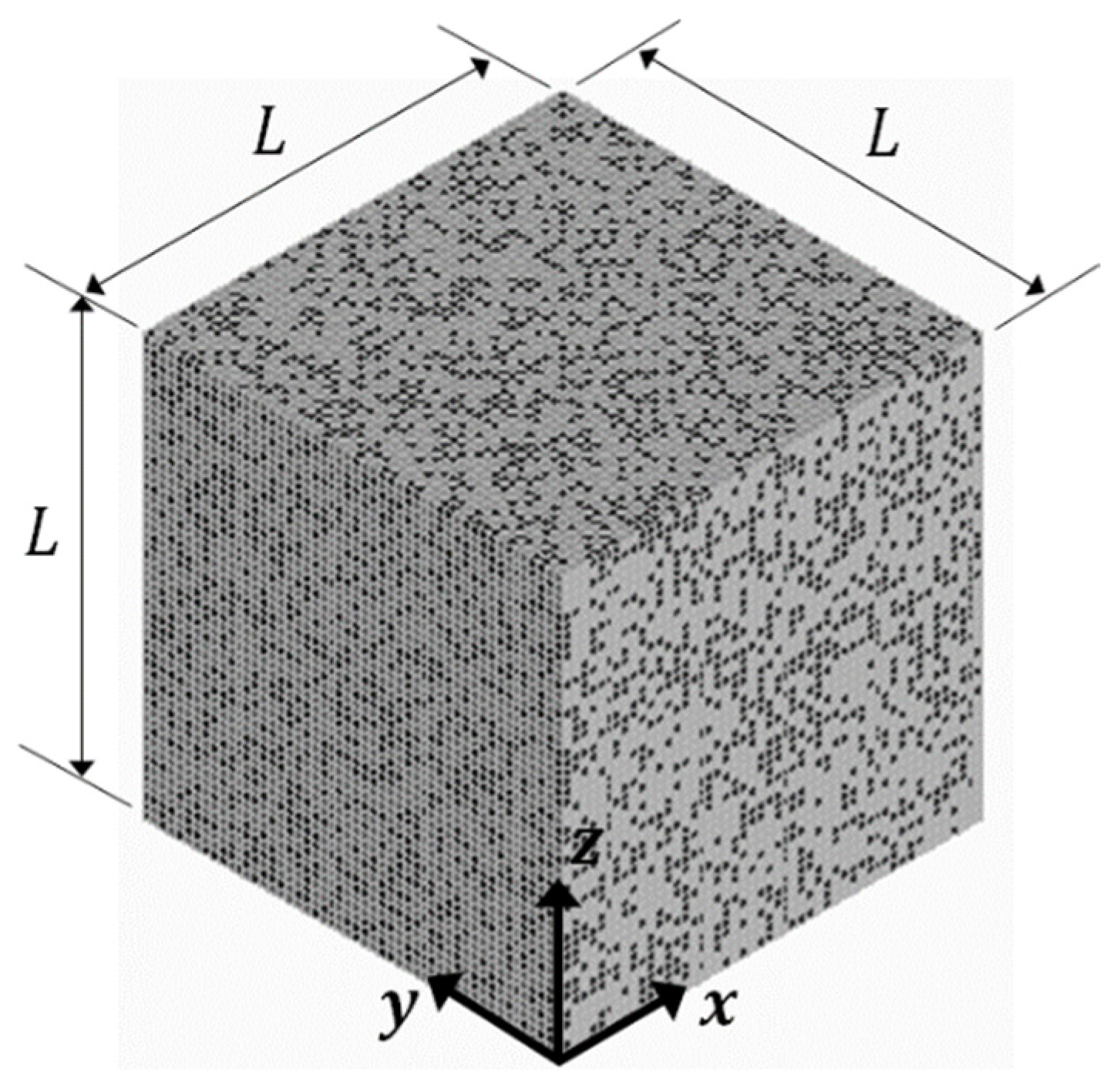
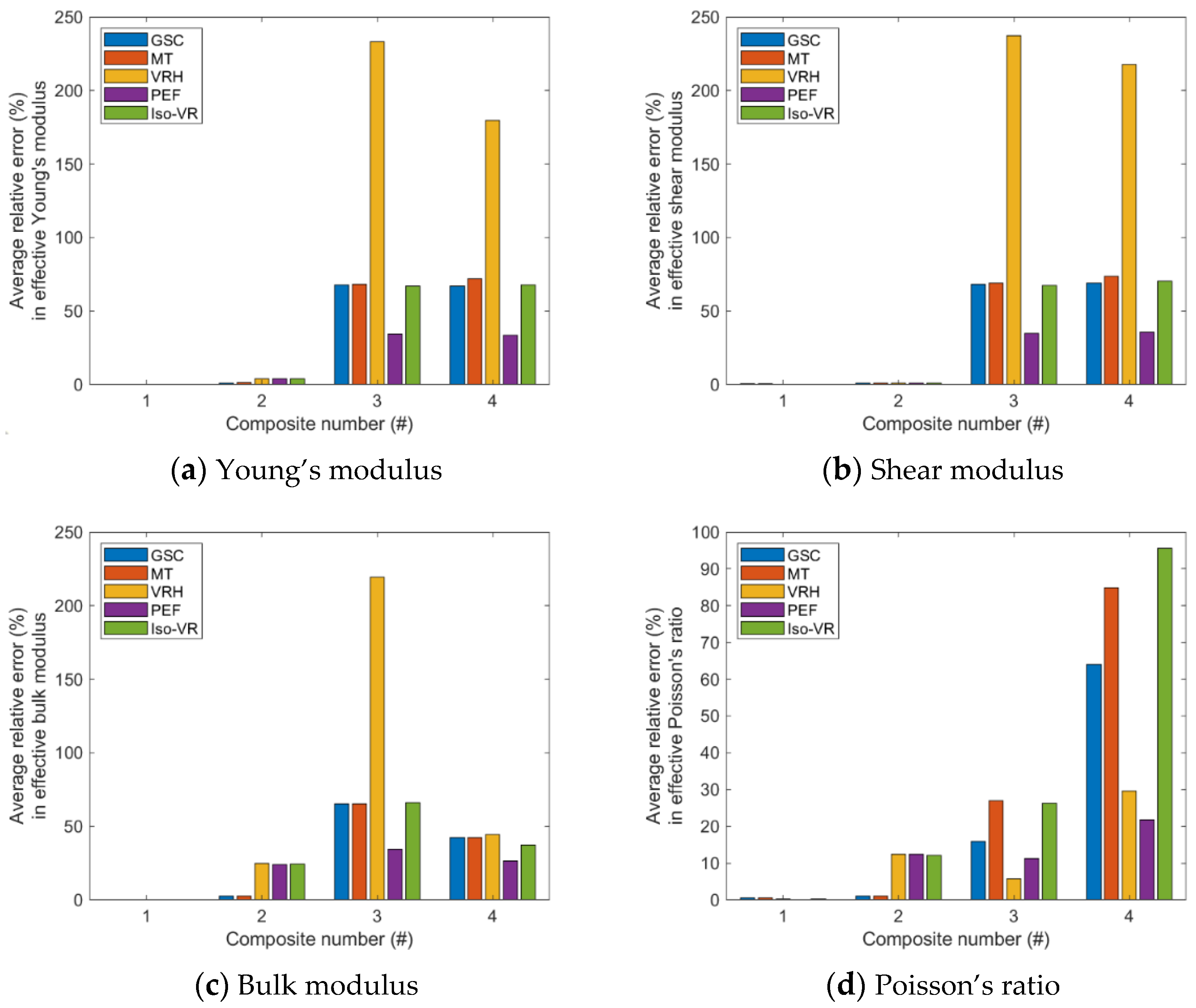
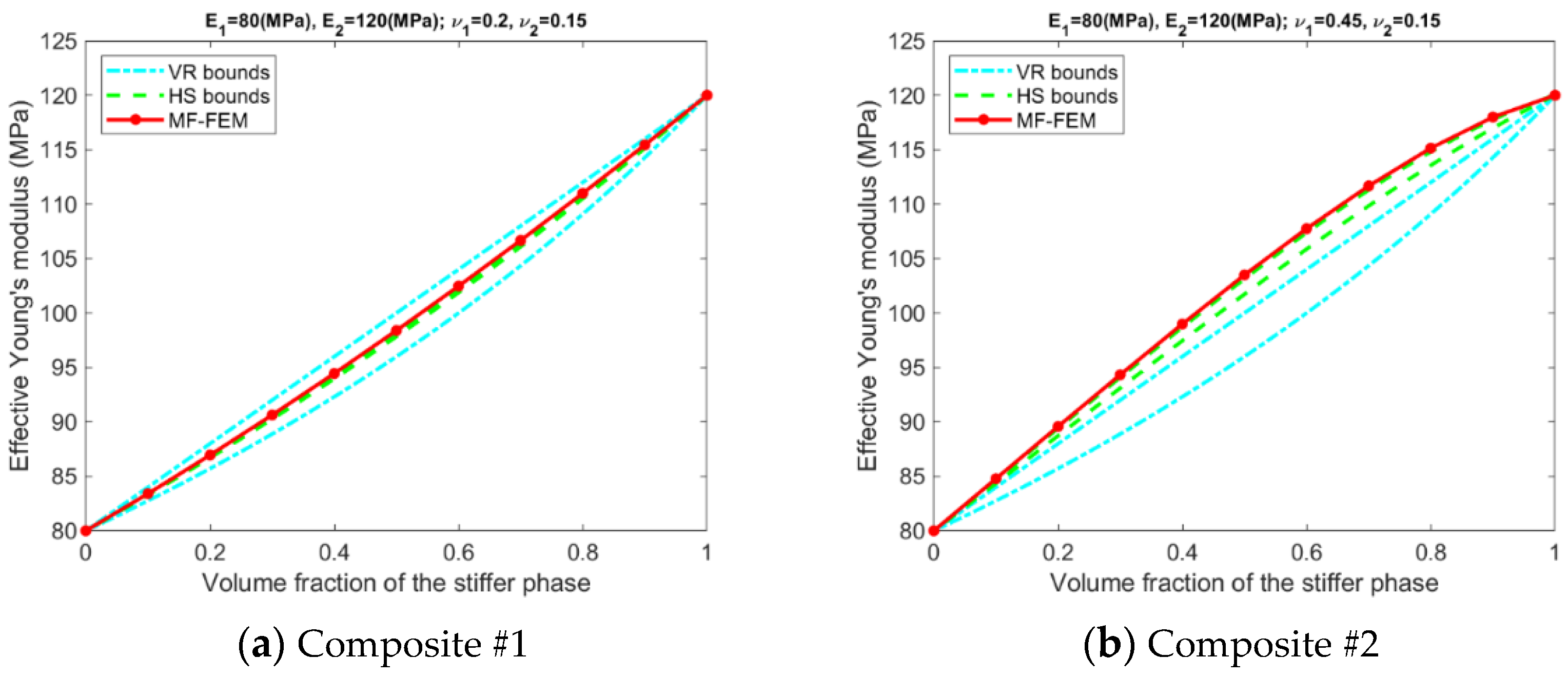
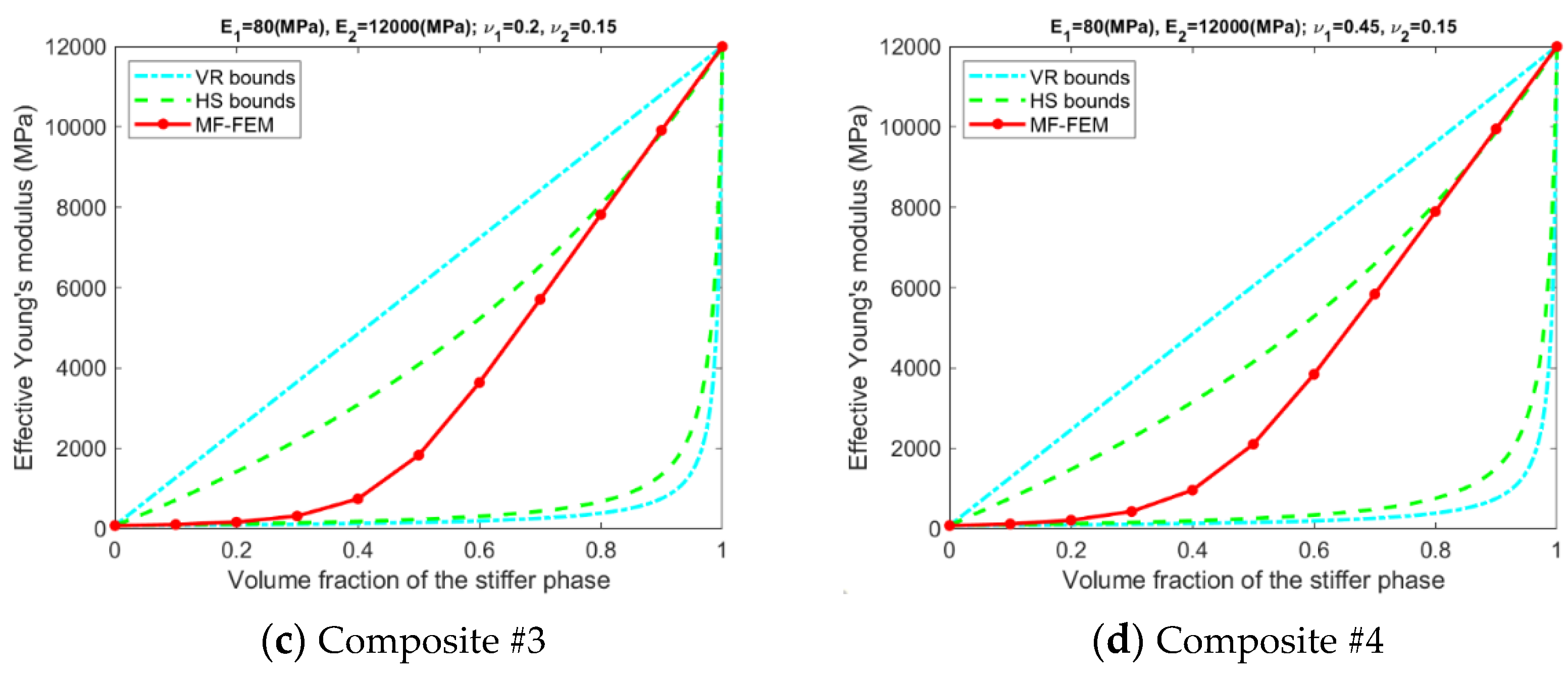
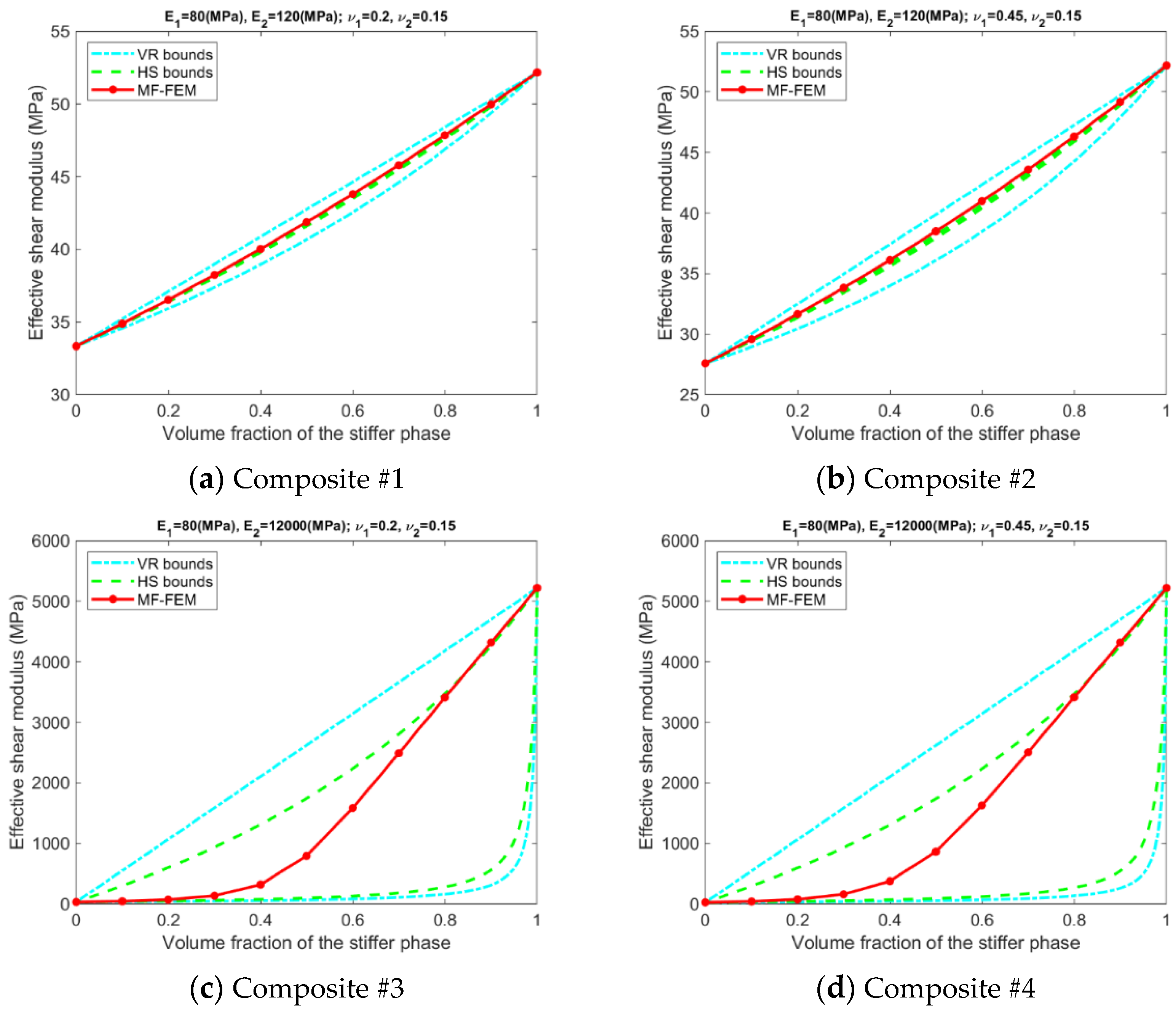
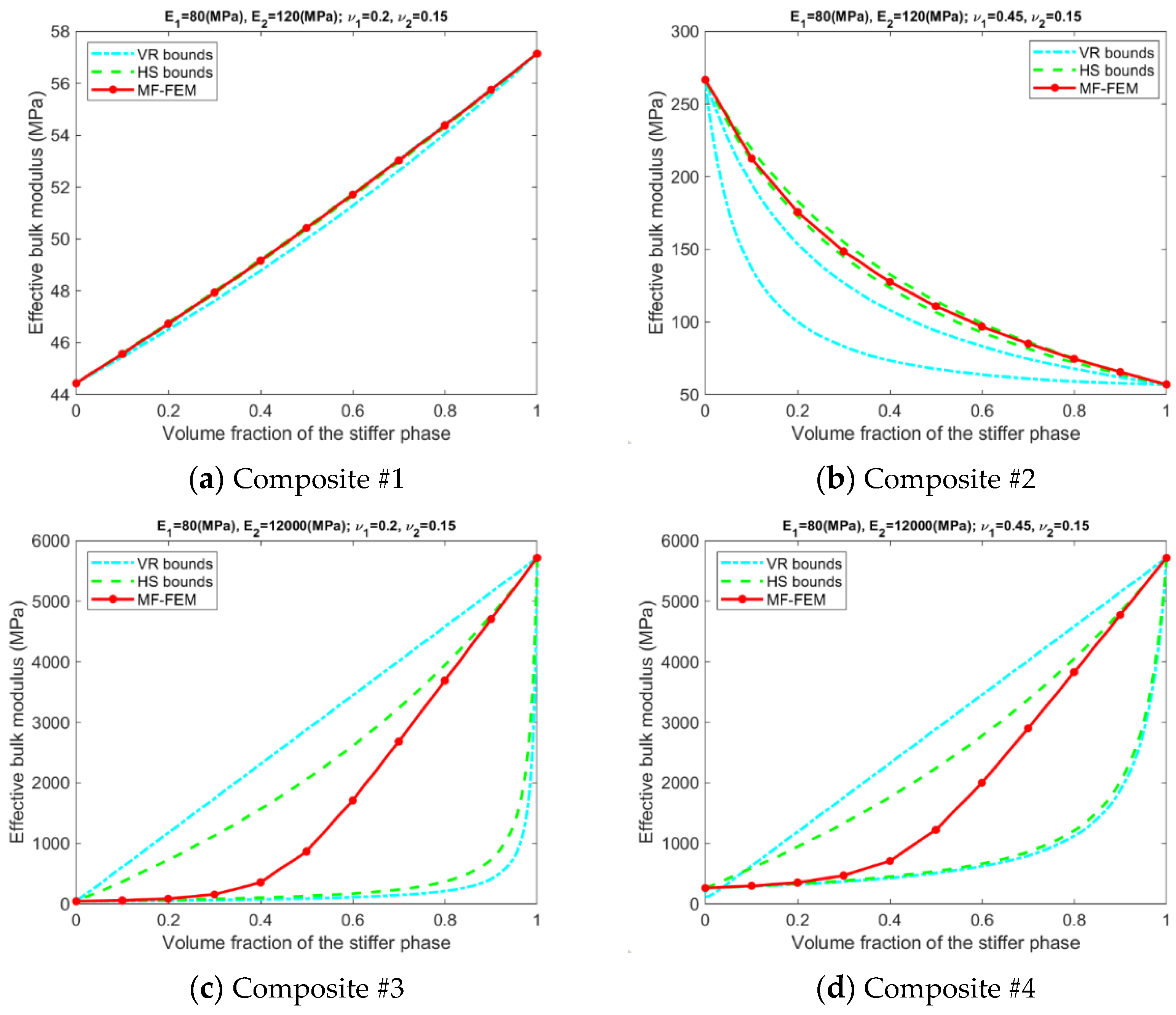
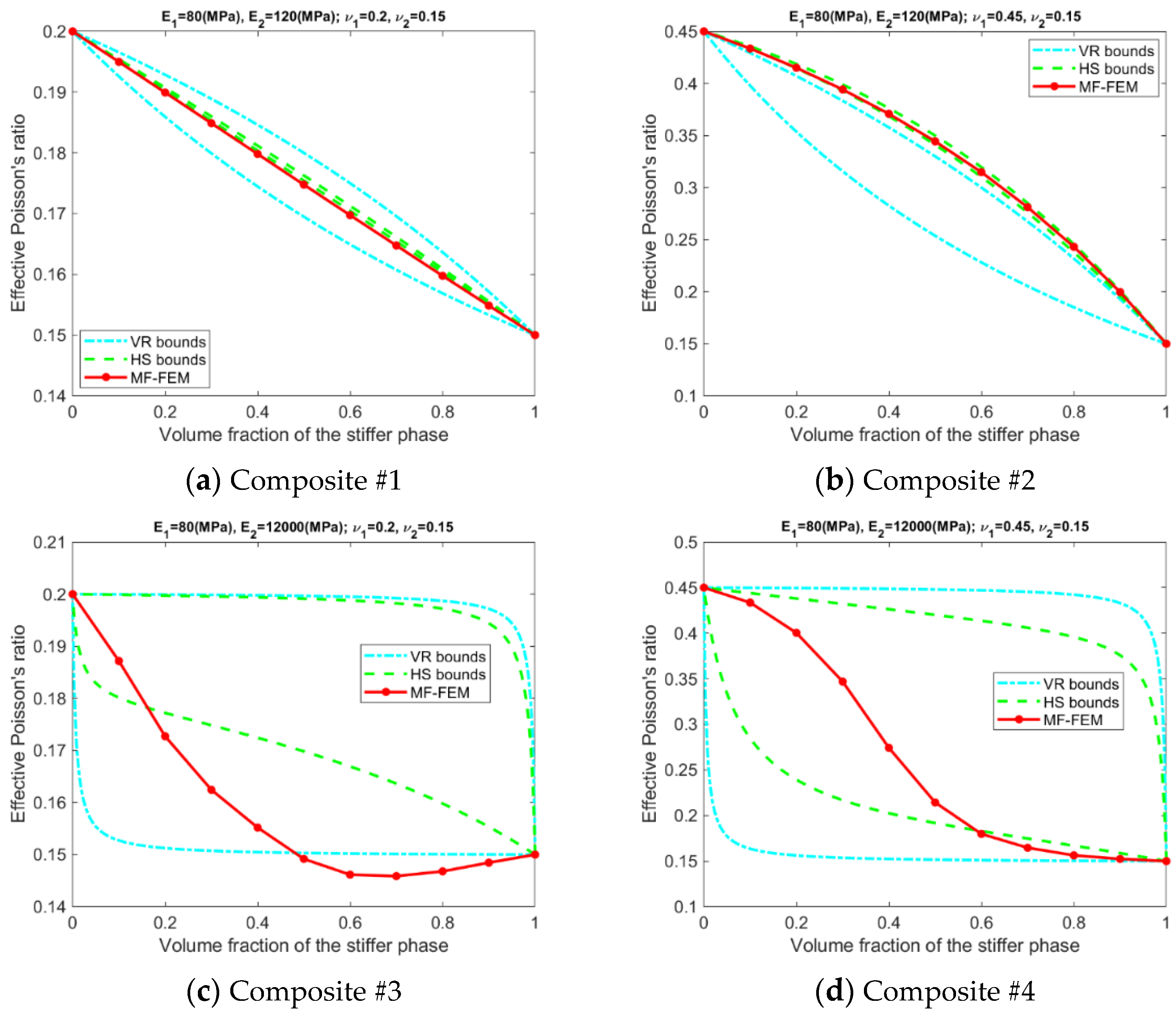
| Composite # | Softer Phase | Stiffer Phase | Phase Contrast | |||
|---|---|---|---|---|---|---|
| Young’s Modulus (MPa) | Poisson’s Ratio | Young’s Modulus (MPa) | Poisson’s Ratio | Young’s Modulus | Poisson’s Ratio | |
| 1 | 80.0 | 0.20 | 120.0 | 0.15 | Small | Small |
| 2 | 80.0 | 0.45 | 120.0 | 0.15 | Small | Large |
| 3 | 80.0 | 0.20 | 12,000.0 | 0.15 | Large | Small |
| 4 | 80.0 | 0.45 | 12,000.0 | 0.15 | Large | Large |
| Young’s modulus of phase i | Effective Young’s modulus of the composite | |||
| Shear modulus of phase i | Effective shear modulus of the composite | |||
| Bulk modulus of phase i | Effective bulk modulus of the composite | |||
| Poisson’s ratio of phase i | Effective Poisson’s ratio of the composite | |||
| Volume fraction of phase i | Generic property of the composite and phase i |
| RVE Surface | Young’s Modulus ( ) and Poisson’s Ratio ( ) | ||
|---|---|---|---|
| Homogeneous | Homogeneous | ||
| Homogeneous | Homogeneous | ||
| Homogeneous | Homogeneous | ||
| Young’s Modulus ( ) | Shear Modulus ( ) | Bulk Modulus ( ) | Poisson’s Ratio ( ) | |
|---|---|---|---|---|
| MF-FEM | x | x | ||
| VR bounds | x | x | ||
| HS bounds | x | x | ||
| VRH | x | x | ||
| MT | x | x | ||
| GSC | x | x | ||
| Iso-VR | x | x | ||
| PEF | x | x |
Publisher’s Note: MDPI stays neutral with regard to jurisdictional claims in published maps and institutional affiliations. |
© 2022 by the author. Licensee MDPI, Basel, Switzerland. This article is an open access article distributed under the terms and conditions of the Creative Commons Attribution (CC BY) license (https://creativecommons.org/licenses/by/4.0/).
Share and Cite
Luo, Y. An Accuracy Comparison of Micromechanics Models of Particulate Composites against Microstructure-Free Finite Element Modeling. Materials 2022, 15, 4021. https://doi.org/10.3390/ma15114021
Luo Y. An Accuracy Comparison of Micromechanics Models of Particulate Composites against Microstructure-Free Finite Element Modeling. Materials. 2022; 15(11):4021. https://doi.org/10.3390/ma15114021
Chicago/Turabian StyleLuo, Yunhua. 2022. "An Accuracy Comparison of Micromechanics Models of Particulate Composites against Microstructure-Free Finite Element Modeling" Materials 15, no. 11: 4021. https://doi.org/10.3390/ma15114021
APA StyleLuo, Y. (2022). An Accuracy Comparison of Micromechanics Models of Particulate Composites against Microstructure-Free Finite Element Modeling. Materials, 15(11), 4021. https://doi.org/10.3390/ma15114021






